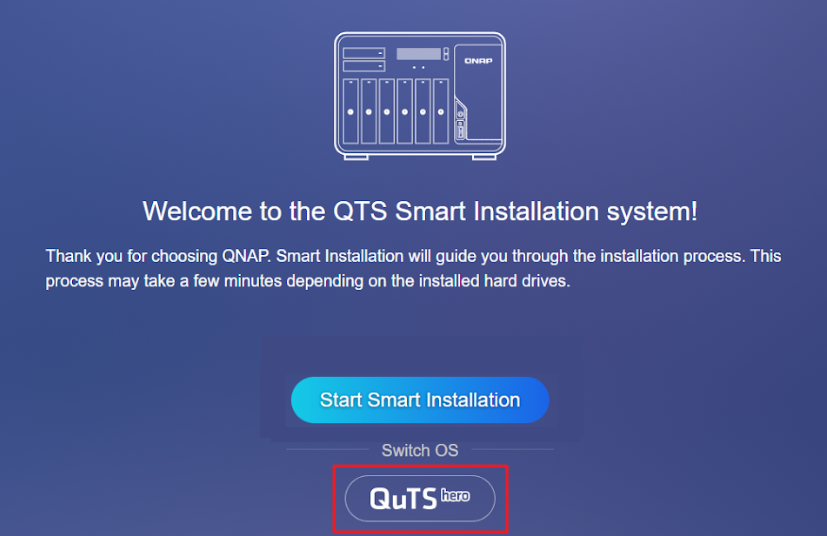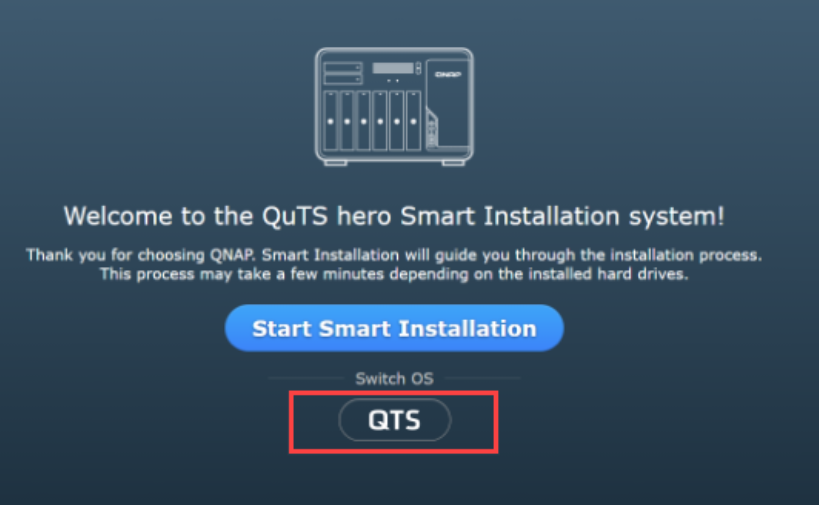Applicable Products
NAS (QTS / QuTS hero)
Scenario
Some QNAP NAS models support both QTS (a modern app-based NAS OS with ext4 file system) and QuTS hero (an advanced, ZFS-based NAS OS). If you want to change your NAS operating system, this article explains how to safely switch from one to the other and highlights key benefits and considerations for each.
Solution
Switching from QTS to QuTS hero
Benefits of QuTS hero (ZFS)
- Data integrity and self-healing: ZFS provides end-to-end checksums that detect and correct data corruption, and supports copy-on-write snapshots.
- Efficient storage: Inline data deduplication and compression saves space.
Note: At least 32 GB RAM is recommended for optimal performance of these features. - Advanced protection and disaster recovery: SnapSync enables near-real-time, snapshot-based backup and disaster recovery across QuTS hero NAS devices.
- Large shared folder support: Single ZFS shared folders can be up to 5 petabytes (PB).
- WORM (Write Once, Read Many): Data can be locked against modification, supporting compliance needs.
Procedure
Important
Switching to QuTS hero will erase all data on your NAS. Make sure to back up your data before starting.
- Power off your NAS and remove all storage devices, including M.2 SSDs.
- Ensure your NAS is connected to the internet, then power it on.
- Sign in to the NAS. The QuTS hero Smart Installation screen will appear.
- Select QuTS hero under the Switch OS heading and follow the on-screen instructions to complete the installation.
- After installation, power off the NAS, reinstall your storage devices, and restart the NAS.

Switching from QuTS hero to QTS
Benefits of QTS (ext4/LVM)
- Qtier auto-tiering (QTS only): Automatically moves frequently accessed ("hot") data to SSDs and less-used ("cold") data to HDDs within the same storage pool.
- Lower system overhead: QTS runs efficiently even on NAS models with less than 8 GB of RAM, making it a good choice for entry-level hardware.
- Wide app compatibility: QTS supports a large selection of QNAP and third-party applications.
- LVM (Logical Volume Manager): Enables flexible volume and storage management.
Procedure
Important
Switching to QTS will erase all data on your NAS. Make sure to back up your data before starting.
- Power off your NAS and remove all storage devices, including M.2 SSDs.
- Ensure your NAS is connected to the internet, then power it on.
- Sign in to the NAS. The QTS Smart Installation screen will appear.
- Select QTS under the Switch OS heading and follow the on-screen instructions to complete the installation.
- After installation, power off the NAS, reinstall your storage devices, and restart the NAS.

Which operating system should I choose?
| Choose QuTS hero (ZFS) if you want... | Choose QTS (ext4/LVM) if you want... |
|---|
- ZFS self-healing, integrity and robust snapshots
- Data deduplication and compression
- Large single shared folders (up to 5 PB)
- SnapSync for disaster recovery
- WORM compliance features
| - Auto-tiering (Qtier for SSD/HDD in a single pool)
- Lower resource overhead on entry-level hardware
- Extensive QNAP app ecosystem
- Simpler, traditional NAS experience
- Recommended for systems with less than 8 GB RAM
|
Further Reading
적용되는 제품
NAS (QTS / QuTS hero)
시나리오
일부 QNAP NAS 모델은 QTS(현대적인 앱 기반 NAS OS로 ext4 파일 시스템 사용)와QuTS hero(고급 ZFS 기반 NAS OS)를 모두 지원합니다. NAS 운영 체제를 변경하려면 이 문서에서 안전하게 전환하는 방법과 각 운영 체제의 주요 이점 및 고려 사항을 설명합니다.
솔루션
QTS에서QuTS hero로 전환
QuTS hero(ZFS)의 이점
- 데이터 무결성과 자가 치유:ZFS는 데이터 손상을 감지하고 수정하는 종단 간 체크섬을 제공하며, copy-on-write 스냅샷을 지원합니다.
- 효율적인스토리지:인라인 데이터중복 제거및 압축으로 공간을 절약합니다.
참고: 이러한 기능의 최적 성능을 위해 최소 32GB RAM이 권장됩니다. - 고급 보호 및 재해 복구:SnapSync는QuTS hero NAS 장치 간에 거의 실시간으로 스냅샷 기반 백업 및 재해 복구를 가능하게 합니다.
- 대용량 공유 폴더 지원:단일 ZFS 공유 폴더는 최대 5 페타바이트(PB)까지 가능합니다.
- WORM(Write Once, Read Many):데이터는 수정이 불가능하게 잠글 수 있으며, 준수 요구 사항을 지원합니다.
절차
중요
QuTS hero로 전환하면 NAS의 모든 데이터가 삭제됩니다. 시작하기 전에 데이터를 백업하십시오.
- NAS의 전원을 끄고 M.2 SSD를 포함한 모든스토리지장치를 제거하십시오.
- NAS가 인터넷에 연결되어 있는지 확인한 후 전원을 켜십시오.
- NAS에 로그인합니다. QuTS hero스마트 설치 화면이 나타납니다.
- 선택QuTS hero운영 체제 전환 항목 아래에서 선택하고 화면 지시사항에 따라 설치를 완료하십시오.
- 설치 후 NAS의 전원을 끄고스토리지장치를 다시 설치한 후 NAS를 재시작하십시오.

QuTS hero에서 QTS로 전환
QTS(ext4/LVM)의 이점
- Qtier 자동 계층화(QTS 전용):자주 액세스되는("핫") 데이터를 SSD로, 덜 사용되는("콜드") 데이터를 동일한스토리지풀 내의 HDD로 자동으로 이동합니다.
- 시스템 오버헤드 감소:QTS는 8GB 미만의 RAM을 가진 NAS 모델에서도 효율적으로 실행되어, 입문자용 하드웨어에 적합한 선택입니다.
- 광범위한 앱 호환성:QTS는 다양한 QNAP 및 타사 애플리케이션을 지원합니다.
- LVM (논리 볼륨 관리자):유연한 볼륨 및스토리지관리를 가능하게 합니다.
절차
중요
QTS로 전환하면 NAS의 모든 데이터가 삭제됩니다. 시작하기 전에 데이터를 백업하십시오.
- NAS의 전원을 끄고 M.2 SSD를 포함한 모든스토리지장치를 제거하십시오.
- NAS가 인터넷에 연결되어 있는지 확인한 후 전원을 켜십시오.
- NAS에 로그인합니다. QTS 스마트 설치 화면이 나타납니다.
- 선택QTSSwitch OS 항목 아래에서 선택하고 화면 지시사항에 따라 설치를 완료합니다.
- 설치 후 NAS의 전원을 끄고스토리지장치를 다시 설치한 후 NAS를 재시작합니다.

어떤 운영 체제를 선택해야 합니까?
| 원하는 경우QuTS hero (ZFS)를 선택하십시오... | 원하는 경우 QTS (ext4/LVM)를 선택하십시오... |
|---|
- ZFS 자가 치유, 무결성 및 강력한스냅샷
- 데이터중복 제거및 압축
- 대형 단일 공유 폴더 (최대 5 PB)
- 재해 복구를 위한SnapSync
- WORM 준수 기능
| - 자동 계층화 (단일 풀에서 SSD/HDD용 Qtier)
- 입문자용 하드웨어에서 낮은 리소스 오버헤드
- 광범위한 QNAP 앱 에코시스템
- 더 간단하고 전통적인 NAS 경험
- 8GB 미만의 RAM을 가진 시스템에 권장
|
추가 읽기







